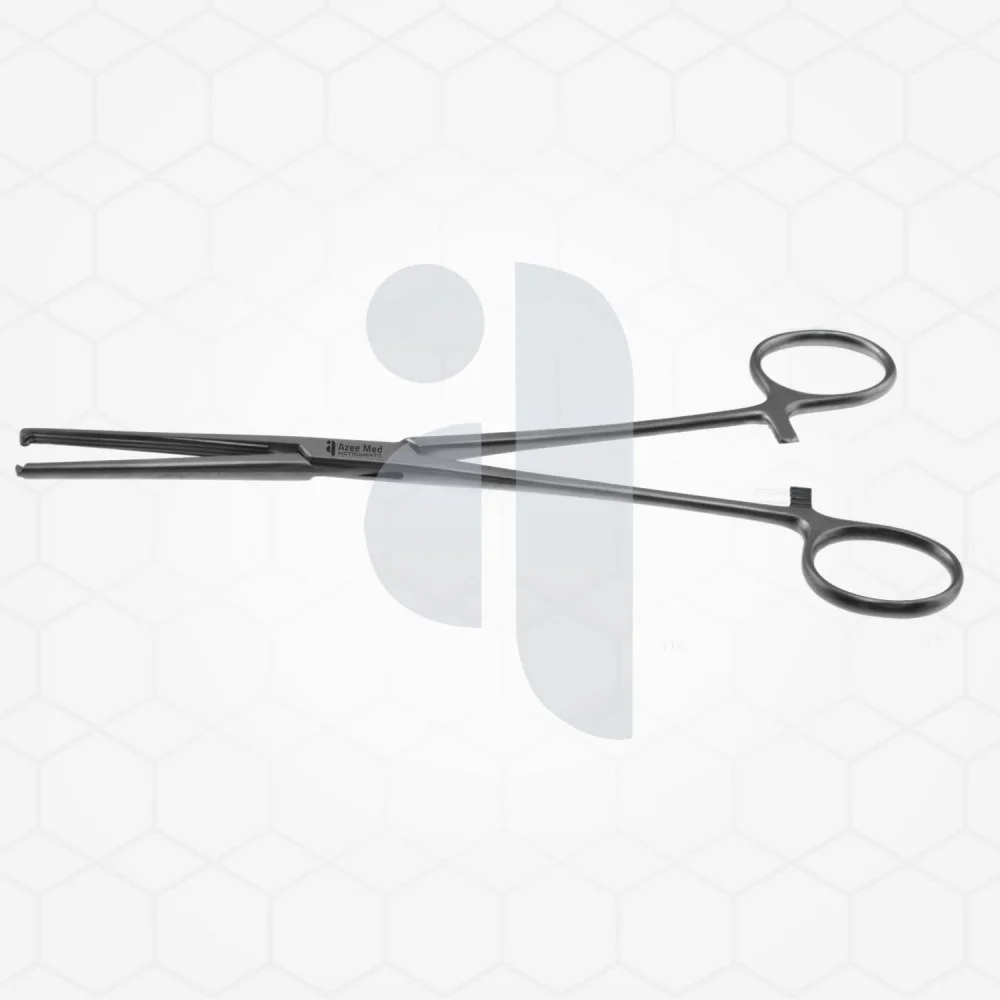Bowel clamps are specialized surgical instruments used in gastrointestinal (GI) procedures to temporarily occlude sections of the intestine. These clamps allow surgeons to control the movement of intestinal contents, minimize contamination, and create a clear surgical field. Bowel clamps are designed to apply gentle but firm pressure, ensuring that tissues are held securely without excessive trauma or damage. They play a crucial role in surgeries such as bowel resections, anastomoses, and colostomies.
Design and Features of Bowel Clamps
Bowel clamps typically have a long, curved or straight structure with smooth or lightly serrated jaws that provide a secure grip while minimizing tissue damage. Unlike hemostatic clamps, which are designed to constrict blood vessels, bowel clamps are atraumatic to prevent unnecessary pressure on delicate intestinal tissues. The handles often include a ratchet locking mechanism that allows for adjustable pressure, ensuring a secure hold without excessive force.
These clamps are made from high-quality stainless steel to withstand repeated sterilization and provide long-term durability. Some models have coated or plastic-covered jaws to further reduce the risk of crushing or injuring the bowel during prolonged procedures. Their ergonomic design allows for easy handling and precise maneuvering in complex surgical environments.
Types of Bowel Clamps
There are several types of bowel clamps designed for different surgical needs. The Doyen intestinal clamp is one of the most commonly used instruments, featuring long, flexible jaws with a non-crushing grip that gently occludes the bowel without disrupting blood flow. Kocher intestinal clamps, in contrast, have a stronger grip and are often used in procedures where firmer control is needed.
The Dennis intestinal clamp is another variation designed to provide a balance between firm holding and tissue protection. These clamps are available in both straight and curved configurations, allowing surgeons to work in different anatomical regions with ease. Some specialized clamps are designed with angled jaws to reach deeper sections of the bowel during laparoscopic or open abdominal surgeries.
Applications of Bowel Clamps in Surgery
Bowel clamps are essential in a variety of gastrointestinal surgeries. In bowel resection procedures, they help isolate the diseased section of the intestine before it is removed. They also assist in anastomosis, where two sections of the intestine are joined together after a portion has been removed. The use of bowel clamps in these procedures ensures that no intestinal contents leak into the surgical site, reducing the risk of infection.
These clamps are also used in emergency surgeries, such as in cases of bowel obstruction, perforation, or ischemia. In such situations, surgeons rely on bowel clamps to control the affected segment and prevent further complications. They are equally valuable in colostomy and ileostomy procedures, where sections of the bowel are brought to the surface of the abdomen to create a stoma for waste elimination.
Importance of Proper Handling and Maintenance
Bowel clamps must be handled with care to maintain their effectiveness. After each use, they should be thoroughly cleaned, sterilized, and inspected for any signs of wear or damage. Proper maintenance ensures that the clamps remain functional and safe for future procedures. Storing them in a dry, sterile environment prevents rust and degradation, preserving their performance over time.
Regular inspection of the ratchet mechanism and jaw alignment is essential to ensure that the clamps function properly during surgery. Surgeons and surgical staff must also be trained in the appropriate use of bowel clamps to minimize unnecessary pressure on tissues and prevent complications such as ischemia or bowel perforation.
Advancements in Bowel Clamping Technology
Innovations in surgical instruments have led to improvements in bowel clamp designs. Modern clamps now incorporate lightweight materials for easier handling and enhanced maneuverability. Some clamps feature adjustable pressure controls, allowing surgeons to fine-tune the grip strength based on the specific needs of the procedure.
Laparoscopic bowel clamps have also been developed for minimally invasive surgeries, providing the same level of control in a less invasive manner. These clamps allow for precise manipulation of the bowel through small incisions, reducing patient recovery time and postoperative complications.
Conclusion
Bowel clamps are indispensable tools in gastrointestinal surgery, ensuring safe and efficient handling of the intestine during complex procedures. Their atraumatic design, durability, and variety of configurations make them essential for maintaining a controlled surgical environment. Proper maintenance and advancements in clamp technology continue to improve surgical outcomes, providing patients with safer and more effective treatments. As surgical techniques evolve, bowel clamps will remain a critical component in both open and minimally invasive gastrointestinal procedures.





Comments